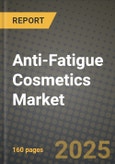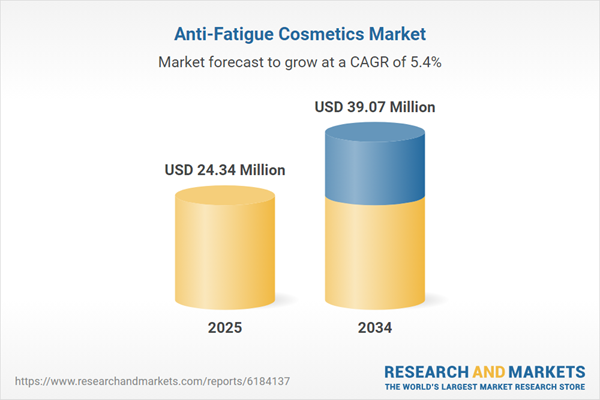Anti-Fatigue Cosmetics Market
The anti-fatigue cosmetics market spans skincare and hybrid makeup designed to counter visible signs of tiredness - dullness, puffiness, dark circles, dehydration lines, and uneven tone. Core formats include energizing serums and essences; vitamin-C and niacinamide brighteners; peptide and caffeine eye creams; hydrating gels and mists; primers and tinted moisturizers with light-diffusing pigments; color correctors; and on-the-go sticks/ampoules. End-uses range from daily urban defense and office-to-evening refresh to travel kits, pre-meeting touch-ups, and post-workout routines. Trends emphasize multi-benefit “skinification” (active-rich bases with immediate optical blurring), microbiome-friendly and fragrance-reduced formulas, and cooling tools (metal tips, cryo-ceramic rollers) for de-puffing. Brands deploy encapsulated actives for stability (vitamin C, retinoid esters), slow-release caffeine and peptides for microcirculation and barrier support, and humectant networks (HA/polyglutamic acid) layered with emollients to restore glow. Blue-light and pollution defense, antioxidant polyphenols, and adaptogen extracts broaden wellness appeal, while shade-flexible tints and sheer correctors bridge skincare and makeup. Digital levers - D2C, virtual try-on, diagnostic apps - reshape discovery and replenishment; retailers elevate dermocosmetic positioning with ophthalmologist/dermatologist-tested claims. Competitive intensity spans multinational beauty houses, clinical-leaning dermocosmetic brands, K-beauty/J-beauty innovators, and clean indie labels; differentiation rests on fast sensory payoff, credible clinical substantiation, low-irritancy profiles, and sustainable packaging (airless, refillable, recycled resins). Key challenges include crowded shelves, claim substantiation standards, sensitivity to fragrances/colorants, and maintaining luminous finishes without greasiness across diverse climates and skin types. Players pairing instant optical effects with measurable long-term skin benefits and inclusive tone coverage are best positioned.Anti-Fatigue Cosmetics Market Key Insights
- Skinification of makeup
- Brightening plus barrier repair
- Caffeine and peptide eye strategies
- Optical engineering for instant results
- Stability via encapsulation
- Pollution and blue-light defense
- Microbiome-minded minimalism
- Inclusive tint and shade tech
- Formats for convenience
- Sustainability as a tie-breaker
Anti-Fatigue Cosmetics Market Reginal Analysis
North America
Consumers seek fast payoff with clinical credibility - vitamin-C serums, peptide eye creams, and hybrid primers dominate routines. Retailers elevate dermocosmetics and fragrance-reduced lines; influencers drive content around “workday revive” and travel-friendly kits. Shade inclusivity and refillable packaging affect shelf placement, while sensitivity-safe claims reduce return rates.Europe
Dermatology-aligned brands lead with fragrance-light, ophthalmologist-tested eye care and antioxidant shields for urban commuters. Regulatory rigor raises the bar for brightening and blue-light claims, favoring evidence-backed actives. Sustainable packaging and minimalist INCI lists resonate, with pharmacy and premium department channels setting trends.Asia-Pacific
K-beauty/J-beauty drive multiphase routines: essences, mists, and gel creams with watery glow and non-sticky finishes. Lightweight tints and color correctors are popular in humid climates; cooling tools and sheet-mask ampoules power travel retail. High adoption of digital skin diagnostics and refill bars supports rapid product cycling.Middle East & Africa
Heat and dehydration elevate demand for long-wear hydration gels, anti-puff eye applicators, and transfer-resistant hybrid tints. Retailers emphasize non-comedogenic, sweat-resilient finishes and halal-aligned ingredient policies in select markets. Travel channels and prestige malls foster premium discovery sets.South & Central America
Urban consumers favor brightening serums and primers that endure humidity while avoiding heaviness. Value-conscious shoppers adopt multi-use sticks and shade-flexible tints; local influencers amplify dermocosmetic education. Distributors with strong pharmacy presence and efficient replenishment win amid fast-moving promotional calendars.Anti-Fatigue Cosmetics Market Segmentation
By Product
- Cream
- Oil
- Lotion
- Serum
- Gel
- Others
By End-User
- Women
- Men
By Distribution Channel
- Offline
- Online
Key Market players
L’Oréal Group, The Estée Lauder Companies, Unilever, Procter & Gamble, Shiseido Company, Limited, LVMH, Beiersdorf AG, Kao Corporation, Amorepacific Corporation, L’Occitane Group, Clarins Group, Kenvue Inc., Coty Inc., Pierre Fabre Dermo-Cosmétique, Rohto Pharmaceutical Co., Ltd.Anti-Fatigue Cosmetics Market Analytics
The report employs rigorous tools, including Porter’s Five Forces, value chain mapping, and scenario-based modelling, to assess supply-demand dynamics. Cross-sector influences from parent, derived, and substitute markets are evaluated to identify risks and opportunities. Trade and pricing analytics provide an up-to-date view of international flows, including leading exporters, importers, and regional price trends.Macroeconomic indicators, policy frameworks such as carbon pricing and energy security strategies, and evolving consumer behaviour are considered in forecasting scenarios. Recent deal flows, partnerships, and technology innovations are incorporated to assess their impact on future market performance.
Anti-Fatigue Cosmetics Market Competitive Intelligence
The competitive landscape is mapped through proprietary frameworks, profiling leading companies with details on business models, product portfolios, financial performance, and strategic initiatives. Key developments such as mergers & acquisitions, technology collaborations, investment inflows, and regional expansions are analyzed for their competitive impact. The report also identifies emerging players and innovative startups contributing to market disruption.Regional insights highlight the most promising investment destinations, regulatory landscapes, and evolving partnerships across energy and industrial corridors.
Countries Covered
- North America - Anti-Fatigue Cosmetics market data and outlook to 2034
- United States
- Canada
- Mexico
- Europe - Anti-Fatigue Cosmetics market data and outlook to 2034
- Germany
- United Kingdom
- France
- Italy
- Spain
- BeNeLux
- Russia
- Sweden
- Asia-Pacific - Anti-Fatigue Cosmetics market data and outlook to 2034
- China
- Japan
- India
- South Korea
- Australia
- Indonesia
- Malaysia
- Vietnam
- Middle East and Africa - Anti-Fatigue Cosmetics market data and outlook to 2034
- Saudi Arabia
- South Africa
- Iran
- UAE
- Egypt
- South and Central America - Anti-Fatigue Cosmetics market data and outlook to 2034
- Brazil
- Argentina
- Chile
- Peru
Research Methodology
This study combines primary inputs from industry experts across the Anti-Fatigue Cosmetics value chain with secondary data from associations, government publications, trade databases, and company disclosures. Proprietary modeling techniques, including data triangulation, statistical correlation, and scenario planning, are applied to deliver reliable market sizing and forecasting.Key Questions Addressed
- What is the current and forecast market size of the Anti-Fatigue Cosmetics industry at global, regional, and country levels?
- Which types, applications, and technologies present the highest growth potential?
- How are supply chains adapting to geopolitical and economic shocks?
- What role do policy frameworks, trade flows, and sustainability targets play in shaping demand?
- Who are the leading players, and how are their strategies evolving in the face of global uncertainty?
- Which regional “hotspots” and customer segments will outpace the market, and what go-to-market and partnership models best support entry and expansion?
- Where are the most investable opportunities - across technology roadmaps, sustainability-linked innovation, and M&A - and what is the best segment to invest over the next 3-5 years?
Your Key Takeaways from the Anti-Fatigue Cosmetics Market Report
- Global Anti-Fatigue Cosmetics market size and growth projections (CAGR), 2024-2034
- Impact of Russia-Ukraine, Israel-Palestine, and Hamas conflicts on Anti-Fatigue Cosmetics trade, costs, and supply chains
- Anti-Fatigue Cosmetics market size, share, and outlook across 5 regions and 27 countries, 2023-2034
- Anti-Fatigue Cosmetics market size, CAGR, and market share of key products, applications, and end-user verticals, 2023-2034
- Short- and long-term Anti-Fatigue Cosmetics market trends, drivers, restraints, and opportunities
- Porter’s Five Forces analysis, technological developments, and Anti-Fatigue Cosmetics supply chain analysis
- Anti-Fatigue Cosmetics trade analysis, Anti-Fatigue Cosmetics market price analysis, and Anti-Fatigue Cosmetics supply/demand dynamics
- Profiles of 5 leading companies - overview, key strategies, financials, and products
- Latest Anti-Fatigue Cosmetics market news and developments
Additional Support
With the purchase of this report, you will receive:- An updated PDF report and an MS Excel data workbook containing all market tables and figures for easy analysis.
- 7-day post-sale analyst support for clarifications and in-scope supplementary data, ensuring the deliverable aligns precisely with your requirements.
- Complimentary report update to incorporate the latest available data and the impact of recent market developments.
This product will be delivered within 1-3 business days.
Table of Contents
Companies Mentioned
- L’Oréal Group
- The Estée Lauder Companies
- Unilever
- Procter & Gamble
- Shiseido Company
- Limited
- LVMH
- Beiersdorf AG
- Kao Corporation
- Amorepacific Corporation
- L’Occitane Group
- Clarins Group
- Kenvue Inc.
- Coty Inc.
- Pierre Fabre Dermo-Cosmétique
- Rohto Pharmaceutical Co. Ltd.
Table Information
| Report Attribute | Details |
|---|---|
| No. of Pages | 160 |
| Published | November 2025 |
| Forecast Period | 2025 - 2034 |
| Estimated Market Value ( USD | $ 24.34 Million |
| Forecasted Market Value ( USD | $ 39.07 Million |
| Compound Annual Growth Rate | 5.4% |
| Regions Covered | Global |
| No. of Companies Mentioned | 16 |









